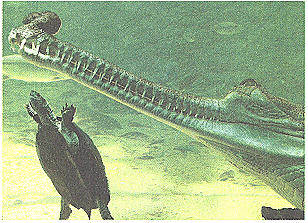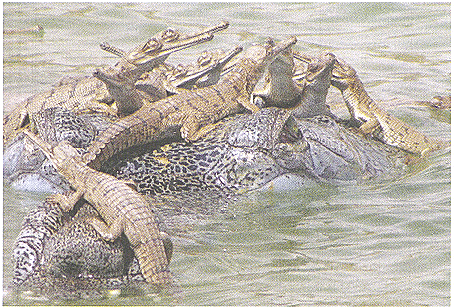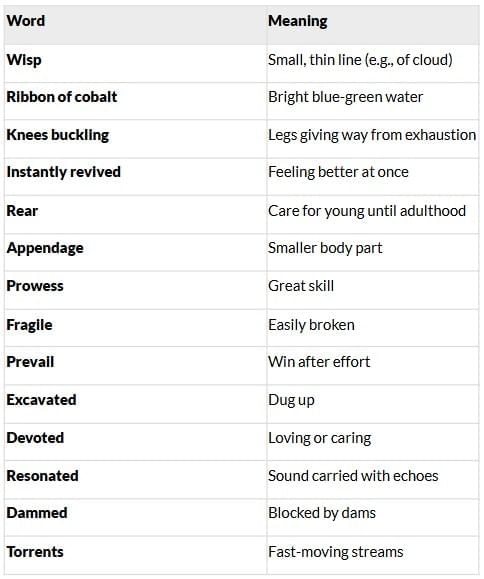Saving the Gharial Chapter Notes | Gul Mohar Class 8: Book Solutions, Summaries & Worksheets PDF Download
| Table of contents |

|
| About the Author |

|
| Key Points |

|
| Detailed Summary |

|
| Theme |

|
| Message |

|
| Vocabulary |

|
About the Author
Janaki Lenin is an Indian filmmaker, book publisher, and writer specializing in Indian wildlife and conservation. Her works highlight endangered species and their habitats. Saving the Gharial narrates her husband Romulus Whitaker’s efforts to conserve the gharial, a unique fish-eating crocodile, blending personal observation with advocacy for river ecosystems.
Key Points
- Romulus Whitaker’s team discovers a female gharial guarding eggs on the River Padma in the 1980s, possibly the last nesting in Bangladesh.
- Gharials have a long snout for catching fish; males develop a “ghara” producing a “buzz-snort” to attract mates and deter rivals.
- Males use territorial jaw-claps and fight aggressively; females compete for nest sites, laying ~50 eggs.
- Captive-breeding reveals attentive parenting, with mothers digging nests and both parents guarding hatchlings.
- Habitat loss from damming, fishing nets, and monsoons has reduced the gharial’s range from 20,000 to 200 square kilometers.
- Project Crocodile (1974) involved breeding and releases, but many gharials were lost to floods or nets.
- The gharial’s survival reflects river health, urging action against pollution and development.
Detailed Summary
In Saving the Gharial, Janaki Lenin recounts Romulus Whitaker’s conservation efforts for the gharial, a river-dwelling crocodile with a distinctive long snout, across India, Bangladesh, and Nepal. In the mid-1980s, Whitaker and his team, exhausted after a long trek, reach the River Padma and discover a female gharial guarding her eggs. They collect the eggs for captive rearing, noting her calm demeanor, possibly marking the last gharial nesting in Bangladesh due to population decline and limited knowledge. 
The gharial’s slender snout is ideal for catching fish, and males develop a “ghara” at adolescence, producing a “buzz-snort” to attract females and warn rivals. Whitaker observes a male’s underwater jaw-clap and aggressive fights at Chambal River, where males clash snouts like swords, often breaking teeth. Females compete fiercely for nest sites, laying about 50 eggs in deep sand nests, camouflaging them from predators like hyenas.
Captive-breeding reveals gharials as attentive parents: mothers dig up nests to free hatchlings, sometimes mistaking objects for their young, and both parents guard babies, with hatchlings climbing onto the male’s head. Project Crocodile, launched in 1974 with UN support, involved surveys, breeding, and releases, but habitat loss from damming, fishing nets, and monsoon floods has reduced the gharial’s range from 20,000 to 200 square kilometers. 
In Satkosia Gorge, only two of seven released gharials survived, often washed away by floods or entangled in nets, unable to feed. The narrative emphasizes that the gharial’s decline mirrors river ecosystem degradation, worsened by pollution and development. Despite 30 years of efforts, the species’ survival remains uncertain, tied to human reliance on rivers, calling for collective action to protect these ecosystems.
Theme
The story explores conservation, human impact on nature, and ecosystem interconnectedness. It highlights how habitat destruction drives wildlife decline and the need to protect natural environments for both animals and humans.
Message
The message is that saving endangered species like the gharial requires protecting their habitats, as their survival mirrors river ecosystem health. Fear of loss and environmental misunderstanding exacerbate decline, but collective action fosters hope for recovery.
Vocabulary

|
32 videos|62 docs|17 tests
|
FAQs on Saving the Gharial Chapter Notes - Gul Mohar Class 8: Book Solutions, Summaries & Worksheets
| 1. What is the significance of the gharial in its ecosystem? |  |
| 2. Why is the gharial population declining? |  |
| 3. What conservation efforts are being made to save the gharial? |  |
| 4. How does the gharial differ from other crocodilian species? |  |
| 5. What can individuals do to help in the conservation of gharials? |  |














